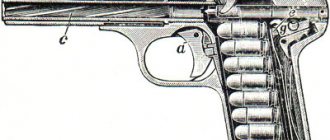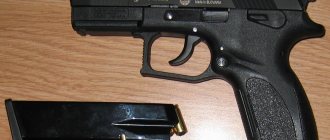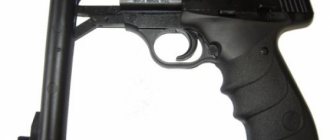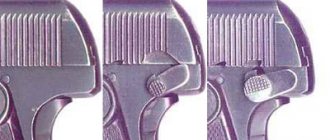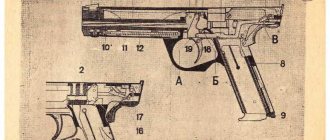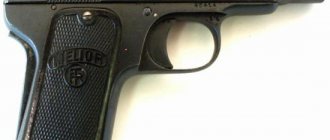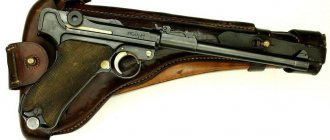Pistol FN Browning GP-35 / P-35 / High Power / Pistole 640(b) / Mk I
| FN Browning GP-35 |
Shortly after the end of the First World War, the legendary American gunsmith John Moses Browning, intending to improve the Colt M 1911, began work on creating a new pistol.
The development was initiated by the Belgian (FN), which acted on the initiative of the French military, interested in obtaining a combat pistol with a magazine capacity of at least 10 rounds, an effective firing range of 50 meters and a weight of no more than 1.0 kg. diagram of the operation of the barrel locking unit in Browning High Power
As a result, in 1921, a model appeared with a striker-type mechanism and a single-row arrangement of cartridges in the magazine. The new weapon used an improved version of the barrel release with a cam, which differs from the Colt M 1911 connecting earring in that under the chamber there is a barrel lug with a specially shaped slot that slides along the figured protrusion of the frame. When the barrel moves backward, the slot causes it to decrease, due to which the lugs of the barrel are disengaged from the grooves inside the bolt-casing.
In 1922, John Browning proposed his design to the Belgian (FN), with which he had been collaborating for a long time. However, the leading designer of FN, Dieudonne Saive, convinced Browning of the need to use a trigger trigger and a magazine with a double-row arrangement of cartridges. John M. Browning was developing this weapon until his death at the end of 1926. And after his death, Didien Save was engaged in fine-tuning the pistol. In the end, by the spring of 1929, a new pistol chambered for the 9x19 mm Parabellum cartridge appeared, which had a trigger trigger, a magazine with a double-row arrangement of 13 rounds with rearrangement upon exit, as well as a rather original release mechanism design, significantly different from all previous Browning designs. Instead of the diagonal rods characteristic of Browning, running on both sides of the walls of the magazine channel, the pistol used a transmission lever mounted in the bolt-casing, which also served as a disconnector.
The French military considered the new FN pistol to be quite successful and met their requirements, but adopted a pistol created in France, abandoning the Belgian model.
In addition, the panic on the New York Stock Exchange in October 1929 and the subsequent severe crisis in world trade prevented the success of this weapon. Only in 1934 did the leaders of Fabrique Nationale decide that the world had finally created the right conditions to launch a new brand of pistol on the market. In the same year, work was carried out for the mass production of the pistol.
The high fighting qualities, and in its time simply unsurpassed, of the new pistol, designated “Pistolet Automatique Browning FN Modele 1935 de Grande Puissance,” interested the Belgian military and in 1935 it was adopted by the Belgian army. It also became known with a shorter designation - “GP-35” (Grande Puissance (fr) - high power) or “P-35” (1935 model pistol). From that time on, the triumphant march of the 1935 Browning pistol began, which soon received another name - “High Power” or “Hi-Power” (High Power (eng) - high power) or abbreviated “HP”, by which it became known throughout world.
| Section of a Browning pistol of the 1935 model: 1 - frame, 3 - base of the magazine latch, 4 - latch pin, 5 - trigger, 6 - trigger rod, 7 - mainspring, 8 - adjusting screw, 9 - trigger spring, 10 - trigger , 11 — trigger axis, 12 — sear, 13 — fuse, 15 — barrel, 16 housing-bolt, 17 — return spring, 18 — guide rod, 19 — firing pin, 20 — firing pin spring, 21 — stop, 22 — trigger lever, 23 — trigger lever axis, 24 — switch, 25 — disconnector, 26 — trigger spring. |
Based on the automatic principle, the 1935 Browning pistol is a weapon with recoil of the barrel and bolt with a short barrel stroke. Full recoil of the bolt after disengagement from the barrel is carried out due to the acquired speed of joint movement. The barrel bore is locked by skewing the barrel in a vertical plane. It is locked and unlocked not with the help of an earring, but thanks to the presence of special protrusions.
FN Browning High Power (explosion diagram)
The pistol consists of a frame, a bolt (bolt-casing), a barrel, and a return mechanism.
The complex pistol frame is milled from a steel forging. The frame contains a bolt stop, a trigger mechanism, handle cheeks and a push-button magazine latch.
The shutter casing is a heavy part with the main mass located in the rear part and forming the shutter. There are recesses on the left wall: the front one for placing the bolt stop tooth, the middle one for fixing the position of the bolt housing when inserting the bolt stop, and the rear one for locking the bolt housing when putting the pistol on safety. There is an outlet window on the right wall, and a notch and a cutout for placing the trigger in the rear part.
The barrel is placed and moves in the front part of the bolt housing. Its movement occurs in such a way that the muzzle slides in the hole in the front wall of the bolt casing, and the thickened breech slides in the internal socket; The barrel cutouts are located under the locking protrusions of the middle part of the bolt casing. The barrel with a thickened breech has a massive lug, the front part of which is an unlocking protrusion, and the rear part is a locking one, equipped with a bevel on top for guiding the cartridges, and two semi-circular grooves for connection with the bolt casing. The internal rifled part of the barrel has six rifling, winding from left to right with a pitch of 248-252 mm.
Under the barrel, in the lug hole of the bolt casing tube, a return spring is placed, resting in front against the tide wall, and at the rear through the guide rod into the barrel lug.
The assembled bolt housing, together with the barrel and the return spring, is placed and moves on the frame.
Single action trigger. Trigger-type impact mechanism with open trigger arrangement. The breaking of the primer is carried out due to the energy of the mainspring, mounted on the trigger rod in the rear part of the pistol handle. The trigger mechanism is not self-cocking, it works only with pre-cocking of the hammer (manually or due to the movement of the bolt). The trigger force of 2.5-3.0 kg meets the desire to make a combat pistol as safe as possible when worn.
Protection against accidental shots is carried out by setting the hammer to the safety cock, and when the hammer is cocked, by a hand-operated safety that simultaneously locks the hammer and the bolt casing. The manually operated safety lever is located on the left side of the frame in front of the butt plate of the handle. Protection against premature shots is carried out by the design of the trigger mechanism itself, which operates only when the bolt casing is in the forward position. In addition, an automatic magazine safety blocks the trigger mechanism in the absence of a magazine.
The long slide stop lever, located on the left side of the frame, is easily operated by the thumb of the shooting hand.
| FN Browning High Power (partial disassembly) |
The weapon is fed with ammunition from a magazine with a capacity of 13 rounds, with a staggered double-row arrangement and an exit neck for one cartridge, due to which the cartridge enters the chamber in a straight line, which increases the reliability of feeding. The magazine is placed in the handle and locked with a latch located at the base of the trigger guard. When all the cartridges are used up, the bolt casing stops in the rear position on the bolt stop. Extraction of the spent cartridge case is carried out by a spring ejector, and reflection is carried out by a special reflector mounted in the rear part of the pistol frame.
Browning High Power Fixed Sight
When the rocker trigger is pulled, the rear of the trigger lever is brought under the front end of a long, horizontal, center-jointed sear lever mounted on the bolt. This disengages the sear from the trigger, the trigger rotates and hits the firing pin. During a shot, the pressure of the powder gases pushes the bolt back, which drags the barrel along with it, because the two upper semi-circular lugs of the barrel fit into the grooves of the bolt-casing. After 5 mm of the recoil stroke, the tide of the barrel meets the rod and the breech of the barrel is lowered. In this case, the lugs of the barrel disengage with the grooves of the bolt-casing, the barrel stops, and the bolt continues to move back, compresses the return spring located under the barrel and cocks the hammer. An open-mounted spring-loaded ejector pulls out the empty cartridge case, which hits the reflector lip and is ejected through the window. The bolt, having reached the limiter, stops and, under the action of the return spring, returns forward, while removing the cartridge from the magazine and sending it into the chamber. The bolt pushes the barrel forward, it rises and engages with the bolt - the barrel bore is locked. If the magazine is empty, its feeder raises the barrel delay, it blocks the bolt-casing in the rear position. After replacing the magazine with a loaded one, the shooter lowers the delay lever, the bolt returns to the forward position, loading and locking. When the magazine is removed, the trigger lever is automatically locked.
The detachable grip cheeks (wooden on the first pistols, then plastic) are secured with screws. The back side of the pistol grip has a bend at the top under the fleshy part of the palm, ensuring a sufficiently deep fit of the pistol in the hand and its stability when fired.
| Browning High Power with Variable Sight |
There were two modifications of the 1935 Browning pistol: the regular one, with a permanent open sight, and the “variable sight model,” which had a sector sight notched for shooting at a distance of up to 500 meters, as well as a groove on the back surface of the handle for attaching a wooden one.
There was also a version of this model with an enlarged sector sight for shooting at a distance of up to 1000 meters, but in this case one can only be surprised at the optimism of the developers. Browning HP sector sight
There is information about other variants of both modifications: for example, there was a regular model of 1935 with a nine-round magazine chambered for 7.65 mm Parabellum and chambered for 7.65 mm Longue, intended for testing and testing in the armies of Switzerland and France, respectively . Neither option went on commercial sale. Some sources also mention the existence of another version of the “model with a variable sight”, which was equipped with a butt and a fire mode translator and, if necessary, could be turned into a submachine gun.
In the second half of the 1930s, orders for the supply of FN Browning GP-35 pistols followed from Lithuania, Latvia, Romania, Estonia, China and Peru. However, the completion of the armament of the armies of these countries was prevented by the Second World War, by the beginning of which the new orders were only partially fulfilled, and, of course, the Belgian armed forces had priority in this matter.
| Pistole 640(b) |
In 1940, after the occupation of Belgium by the troops of Nazi Germany, it was transferred to the German owner, who produced Browning model 1935 under the name “Pistole 640 (b)”. These pistols were used by the German Wehrmacht as limited standard weapons, and their number by the end of World War II was approximately 319,000.
Moreover, in 1940, when it became clear that the production of the FN would fall into the hands of the Germans, the documentation and drawings of the Browning pistol were sent to the UK.
| Browning High Power made in Canada for supply to China |
Browning FN 9 mm Mk I (in version No. 1 Mk I *) produced in Canada
In order to provide the allied armies with Belgian pistols, the British attracted the Canadian (Canada, Toronto) to the production of Browning pistols of the 1935 model. The gun, produced in Canada, was initially produced for supply to China, and then began to be manufactured for the needs of Canada, Great Britain and Australia.
In the British and Canadian armies, pistols produced in Canada received the designation “Browning FN 9 mm Mk I”. They differed from the base model in the shape of the sights and had four grooves in the barrel instead of six, and were produced in four versions: - No. 1 Mk I - with a sector sight designed for a distance of up to 500 meters and grooves for attaching the butt; - No. 1 Mk I * - a variant of model No. 1 Mk I with an improved ejector and a modified sight; — No. 2 Mk I — with a constant sight and without grooves for attaching the butt; - No. 2 Mk I * - variant of model No. 2 Mk I with an improved ejector.
At first, work on the production of Browning pistols in Canada moved slowly, but from February 1944 to September 1945, 151,816 pieces of these weapons were produced.
| Browning FN 9 mm Mk I (in version No. 1 Mk I *) with attached stock |
After the end of World War II, Belgium resumed production of the 1935 Browning with a fixed sight for sale to the military and with an adjustable rear sight under the name High Power for the civilian arms market.
In 1954, the Browning M 1935 pistol was officially approved and adopted by the UK, and in 1962, its modernized version with the designation No. 2 Mk I or L9A1.
Over its long history, the Browning pistol has repeatedly undergone modernizations, during which sighting devices were changed, grooves for the butt were introduced and eliminated, etc. For example, in the 1980s, the Browning High Power Mk II and Mk III models, as well as the BDA, were created with a double-action trigger, in the 1990s the pistol was redesigned for the .40 S&W cartridge, with a reinforced bolt to ensure reliability of the weapon with a more powerful cartridge, and the North American branch of FN began producing the Hi-Power Practical with non-adjustable sights and plastic grip cheeks and Hi-Power Standard with adjustable sights and wooden grips.
| Browning High Power (commercial version) |
At various times, the FN Browning Modele 1935 pistol was adopted by the armies and police forces of over 50 countries, becoming one of the most common military service pistols and earning the title of one of the best pistols of the twentieth century, along with another creation of John Browning - Colt M 1911. In different In different countries, this pistol was called differently, however, the most common was the English-language name for the “High Power” system.
| Caliber, mm | 9×19 |
| Length, mm | 198 |
| Barrel length, mm | 118 |
| Weight without cartridges, kg | 0.910 |
| Store, count. cartridges | 13 |
| Initial bullet speed, m/s | 350 |
The pistol became popular not only as a military and police weapon, but also as a weapon for self-defense or for sports shooting, becoming widespread as a commercial model in the United States and a number of other countries.
Over decades of service and combat use in troops and law enforcement agencies around the world, the High Power pistol has proven itself to be an easy-to-use and trouble-free weapon, demonstrating such qualities as high reliability in difficult operating conditions; simplicity, convenience and safety in handling; ease of weapon maintenance; shooting accuracy; high firepower.
The total number of FN Browning High Power pistols produced was more than 1 million units. In addition, in a number of countries, the production of various modifications of High Power was launched, both under license, for example, “Fabricaciones Militares” in Argentina, and without it in China, “Arcus” in Bulgaria, “FEG” in Hungary, and many others around the world .
| Browning High Power Practical in .40 S&W |
Encyclopedia of weapons
Pistol FN Browning High Power / GP-35 / P-35 / Pistole 640(b) / Mk I
Tactical and technical characteristics of FN Browning Hi-Power: Caliber, mm — 9×19 mm Parabellum Length, mm — 198 Barrel length, mm — 118 Height, mm — 130 Width, mm — 34 Weight without cartridges, g — 910 Magazine capacity — 13 rounds
Shortly after the end of World War I, the legendary American gunsmith John Moses Browning began working on a new pistol. The development was initiated by the Belgian (FN), which acted on the initiative of the French military, interested in obtaining a combat pistol with a magazine capacity of 15 rounds, an effective firing range of 50 meters and a weight of no more than 1.0 kg.
As a result, in 1921 a model appeared with a striker-type mechanism and a single-row arrangement of cartridges in the magazine. The new weapon used an improved version of the barrel release with a cam, which differs from the Colt M1911 connecting earring in that under the chamber there is a barrel lug with a specially shaped slot that slides along the figured protrusion of the frame. When the barrel moves backward, the slot causes it to decrease, due to which the lugs of the barrel are disengaged from the grooves inside the bolt-casing.
In 1922, John Browning proposed his design to the Belgian (FN), with which he had been collaborating for a long time. However, the leading designer of FN, Dieudonne Joseph Saive, convinced Browning of the need to use a trigger trigger and a magazine with a double-row arrangement of cartridges. John M. Browning was developing this weapon until his death at the end of 1926. And after his death, Dieudonne Sav was engaged in fine-tuning the pistol.
In the end, by the spring of 1929, a new pistol chambered for the 9x19 mm Parabellum cartridge appeared, which had a trigger trigger, a double-row magazine for 13 rounds with rearrangement upon exit, as well as a rather original release mechanism design, significantly different from all previous Browning designs . Instead of the diagonal rods characteristic of Browning, running on both sides of the walls of the magazine channel, the pistol used a transmission lever mounted in the bolt-casing, which also served as a disconnector. The shape of the back of the handle was also slightly changed, and in 1931 the pistol became what we know it now.
French experts considered this weapon to be quite successful and meet all their requirements, but their government decided to adopt a model created in France into service with its army, although the SACM Mle 1935A was inferior both in magazine capacity, which was only 8 rounds, and in ammunition power, since the 7.65 mm French Longue (7.65×20) was completely incomparable to the 9 mm Parabellum in either the penetrating or stopping effect of the bullet.
In addition, the panic on the New York Stock Exchange in October 1929 and the subsequent severe crisis in world trade prevented the success of this weapon. Only in 1934 did the leaders of Fabrique Nationale decide that the world had finally created the right conditions to launch a new brand of pistol on the market. In the same year, work was carried out for the mass production of the pistol.
The high fighting qualities, and in its time simply unsurpassed, of the new pistol, designated “Pistolet Automatique Browning FN Modele 1935 de Grande Puissance,” interested the Belgian military and in 1935 it was adopted by the Belgian army. It also became known with a shorter designation - “GP-35” (Grande Puissance (fr) - high power) or “P-35” (1935 model pistol). From that time on, the triumphant march of the 1935 Browning pistol began, which soon received another name - “High Power” or “Hi-Power” (High Power (eng) - high power) or abbreviated “HP”, by which it became known throughout world.
Based on the automatic principle, the Browning High Power pistol is a weapon with recoil of the barrel and bolt with a short barrel stroke. Full recoil of the bolt after disengagement from the barrel is carried out due to the acquired speed of joint movement. The barrel bore is locked by skewing the barrel in a vertical plane. It is locked and unlocked not with the help of an earring, but thanks to the presence of special protrusions.
The pistol consists of a frame, a bolt (shutter-casing), a barrel, and a return mechanism.
The complex pistol frame is milled from a steel forging. The frame contains a bolt stop, a trigger mechanism, handle cheeks and a push-button magazine latch.
The shutter casing is a heavy part with the main mass located in the rear part and forming the shutter. There are recesses on the left wall: the front one for placing the bolt stop tooth, the middle one for fixing the position of the bolt housing when inserting the bolt stop, and the rear one for locking the bolt housing when putting the pistol on safety. There is an outlet window on the right wall, and a notch and a cutout for placing the trigger in the rear part.
The barrel is placed and moves in the front part of the bolt housing. Its movement occurs in such a way that the muzzle slides in the hole in the front wall of the bolt casing, and the thickened breech slides in the internal socket; The barrel cutouts are located under the locking protrusions of the middle part of the bolt casing. The barrel with a thickened breech has a massive lug, the front part of which is an unlocking protrusion, and the rear part is a locking one, equipped with a bevel on top for guiding the cartridges, and two semi-circular grooves for connection with the bolt casing. The internal rifled part of the barrel has six rifling, winding from left to right with a pitch of 248-252 mm.
Under the barrel, in the lug hole of the bolt casing tube, a return spring is placed, resting in front against the tide wall, and at the rear through the guide rod into the barrel lug.
The assembled bolt housing, together with the barrel and the return spring, is placed and moves on the frame.
Single action trigger. Trigger-type impact mechanism with open trigger arrangement. The breaking of the primer is carried out due to the energy of the mainspring, mounted on the trigger rod in the rear part of the pistol handle. The trigger mechanism is not self-cocking, it works only with pre-cocking of the hammer (manually or due to the movement of the bolt). The trigger force of 2.5-3.0 kg meets the desire to make a combat pistol as safe as possible when worn.
Protection against accidental shots is carried out by setting the hammer to the safety cock, and when the hammer is cocked, by a hand-operated safety that simultaneously locks the hammer and the bolt casing. The manually operated safety lever is located on the left side of the frame in front of the butt plate of the handle. Protection against premature shots is carried out by the design of the trigger mechanism itself, which operates only when the bolt casing is in the forward position. In addition, an automatic magazine safety blocks the trigger mechanism in the absence of a magazine.
The long slide stop lever, located on the left side of the frame, is easily operated by the thumb of the shooting hand.
The weapon is fed with ammunition from a magazine with a capacity of 13 rounds, with a staggered double-row arrangement and an exit neck for one cartridge, due to which the cartridge enters the chamber in a straight line, which increases the reliability of feeding. The magazine is placed in the handle and locked with a latch located at the base of the trigger guard. When all the cartridges are used up, the bolt casing stops in the rear position on the bolt stop. Extraction of the spent cartridge case is carried out by a spring ejector, and reflection is carried out by a special reflector mounted in the rear part of the pistol frame.
When the rocking trigger is pressed, the rear part of the trigger lever is brought under the front end of a long horizontal sear lever with a hinge in the middle, mounted on the bolt. This disengages the sear from the trigger, the trigger rotates and hits the firing pin. During a shot, the pressure of the powder gases pushes the bolt back, which drags the barrel along with it, because the two upper semi-circular lugs of the barrel fit into the grooves of the bolt-casing. After 5 mm of the recoil stroke, the tide of the barrel meets the rod and the breech of the barrel is lowered. In this case, the lugs of the barrel disengage with the grooves of the bolt-casing, the barrel stops, and the bolt continues to move back, compresses the return spring located under the barrel and cocks the hammer. An open-mounted spring-loaded ejector pulls out the empty cartridge case, which hits the reflector lip and is ejected through the window. The bolt, having reached the limiter, stops and, under the action of the return spring, returns forward, while removing the cartridge from the magazine and sending it into the chamber. The bolt pushes the barrel forward, it rises and engages with the bolt - the barrel bore is locked. If the magazine is empty, its feeder raises the barrel delay, it blocks the bolt-casing in the rear position. After replacing the magazine with a loaded one, the shooter lowers the delay lever, the bolt returns to the forward position, loading and locking. When the magazine is removed, the trigger lever is automatically locked.
The detachable grip cheeks (wooden on the first pistols, then plastic) are secured with screws. The back side of the pistol grip has a bend at the top under the fleshy part of the palm, ensuring a sufficiently deep fit of the pistol in the hand and its stability when fired.
There were two modifications of the Browning High Power pistol: a regular one, with a permanent open sight, and a “variable sight model”, which had a sector sight notched for shooting at a distance of up to 500 meters, as well as a groove on the back surface of the handle for attaching a wooden one. There was also a version of this model with an enlarged sector sight for shooting at a distance of up to 1000 meters, but in this case one can only be surprised at the optimism of the developers.
There is information about other variants of both modifications: for example, there was a regular model of 1935 with a nine-round magazine chambered for 7.65 mm Parabellum and chambered for 7.65 mm Longue, intended for testing and testing in the armies of Switzerland and France, respectively. Neither option went on commercial sale. Some sources also mention the existence of another version of the “model with a variable sight”, which was equipped with a butt and a fire mode translator and, if necessary, could be turned into a submachine gun.
In the second half of the 1930s, orders for the supply of FN Browning GP-35 pistols followed from Lithuania, Latvia, Romania, Estonia, China and Peru. However, the completion of the armament of the armies of these countries was prevented by the Second World War, by the beginning of which the new orders were only partially fulfilled, and, of course, the Belgian armed forces had priority in this matter.
In 1940, after the occupation of Belgium by the troops of Nazi Germany, it was transferred to the German owner, who produced Browning model 1935 under the name “Pistole 640 (b)”. These pistols were used by the German Wehrmacht as limited standard weapons, and their number by the end of World War II was approximately 319,000.
Moreover, in 1940, when it became clear that the production of the FN would fall into the hands of the Germans, the documentation and drawings of the Browning pistol were sent to the UK.
In order to provide the allied armies with Belgian pistols, the British attracted the Canadian (Canada, Toronto) to the production of Browning pistols of the 1935 model. The gun, produced in Canada, was initially produced for supply to China, and then began to be manufactured for the needs of Canada, Great Britain and Australia.
In the British and Canadian armies, pistols produced in Canada received the designation “Browning FN 9 mm Mk I”. They differed from the base model in the shape of the sights and had four grooves in the barrel instead of six, and were produced in four versions: - No. 1 Mk I - with a sector sight designed for a distance of up to 500 meters and grooves for attaching the butt; - No. 1 Mk I * - a variant of model No. 1 Mk I with an improved ejector and a modified sight; — No. 2 Mk I — with a constant sight and without grooves for attaching the butt; - No. 2 Mk I * - variant of model No. 2 Mk I with an improved ejector.
At first, work on the production of Browning pistols in Canada moved slowly, but from February 1944 to September 1945, 151,816 pieces of these weapons were produced.
After the end of World War II, Belgium resumed production of the 1935 Browning with a fixed sight for sale to the military and with an adjustable rear sight under the name High Power for the civilian arms market.
In 1954, the Browning M1935 pistol was officially approved and adopted by the UK, and in 1962, its modernized version was designated No. 2 Mk I or L9A1.
Over its long history, the Browning pistol has repeatedly undergone modernizations, during which sighting devices were changed, grooves for the butt were introduced and eliminated, etc. For example, in the 1980s, the Browning High Power Mk II and Mk III models, as well as the BDA, were created with a double-action trigger, in the 1990s the pistol was redesigned for the .40 S&W cartridge, with a reinforced bolt to ensure reliability of the weapon with a more powerful cartridge, and the North American branch of FN began producing the Hi-Power Practical with non-adjustable sights and plastic grip cheeks and Hi-Power Standard with adjustable sights and wooden grips.
At various times, the FN Browning Modele 1935 pistol was adopted by the armies and police forces of over 50 countries, becoming one of the most common military service pistols and earning the title of one of the best pistols of the twentieth century, along with another creation of John Browning - the Colt M1911. In different countries, this pistol was called differently, however, the most common was the English name of the “High Power” system.
The FN High Power has become popular not only as a military and police weapon, but also as a weapon for self-defense or for sports shooting, becoming widespread as a commercial model in the United States and a number of other countries. HP is often modified to meet specific requirements by various “customization” companies. For example, the Delux Custom BHP pistol from Novak. Basically, improvements made to the design are made for practical shooting. Adjustable sights with luminous inserts, more convenient enlarged safety and bolt stop levers, handle cheeks of various shapes and wood textures are installed. An additional notch is sometimes applied to the front side surfaces of the bolt casing in order to make it more convenient to operate and to more quickly chamber a cartridge from the magazine into the chamber.
Over decades of service and combat use in troops and law enforcement agencies around the world, the High Power pistol has proven itself to be an easy-to-use and trouble-free weapon, demonstrating such qualities as high reliability in difficult operating conditions; simplicity, convenience and safety in handling; ease of weapon maintenance; shooting accuracy; high firepower.
The total number of FN Browning High Power pistols produced was more than 1 million units. In addition, in a number of countries, the production of various modifications of High Power was launched, both under license, for example, “Fabricaciones Militares” in Argentina, and without it in China, “Arcus” in Bulgaria, “FEG” in Hungary, and many others around the world .
‹ FN Baby Browning Up FN Browning Hi-Power Mk II ›Browning DA / FN HP-DA / BDA9 / BDAO (Belgium)
FN HP-DA (Browning Double Action) - early model.
FN HP-DA / Browning BDA9 - a modern version.
FN HP-DAO / Browning BDAO - a modern version with a double-action only.
FN HP-DAO Compact / Browning BDAO Compact.
FN HP-DA - incomplete disassembly.
Characteristics
USM
: double action or double action only
Caliber
: 9x19mm Luger / Parabellum
Weight empty:
905 g (modern version);
850 g (1980s version); 710 g (compact model) Length:
200 mm;
173 mm - compact model Barrel length:
118 mm;
96 mm - compact model Magazine capacity:
14 rounds; also 7 cartridges for compact model
By the early 1980s, the Belgians from the FN Herstal company finally paid attention to the increased popularity of military (military) pistols with a double-action trigger. The decision was made to use the very popular, but no longer new, Browning High Power (GP35) pistol as the basis for the new pistol. The resulting pistol was designated Browning Double Action (for the American market) or FN HP-DA (for Europe). While very similar to the Browning Model 1935, the new pistol had quite a few differences. Firstly, it had a double-action trigger with a double-sided safety release lever instead of a conventional safety. Secondly, the trigger spoke was shortened and the shape of the trigger guard was changed. Thirdly, the shape of the front part of the bolt has slightly changed. The magazine capacity was increased by 1 round and amounted to 14 rounds. Production began in 1983.
Based on the basic model, Compact (HP-DAC) and Medium (HP-DAM) variants were also created. The Compact variant (HP-DAC) had a shortened barrel and bolt, as well as a reduced handle height, which accommodated a shortened double-stack magazine for 7 rounds. However, standard 14-round magazines were also suitable, although they protruded strongly from the handle downwards. The HP-DAM (Medium) variant was a combination of the frame of the standard model and the shortened barrel and bolt of the compact model.
For various reasons, these pistols were not particularly successful commercially and were discontinued in 1987. However, three years later, FN Herstal managers finally decided to revive the HP-DA, leaving it the old name in Europe and designating the “American” version as Browning BDA9. In addition, a pistol version with a double-action trigger only appeared, under the designation HP-DAO or BDAO. Externally, it differs from the BDA9 in the absence of a trigger spoke and safety release levers. Currently, both BDA9 and BDAO are in production and are successfully sold in both Europe and America. The main external difference between the new HP-DA and the old ones is the shape of the safety trigger levers - on the new models they are longer and triangular in shape, and on the old ones they are shorter and rounded at the top.
From a technical point of view, the FN HP-DA / Browning BDA9 is a self-loading pistol with a double-action trigger (only double for BDAO). The automation operates according to the traditional Browning scheme, with a short barrel stroke and its rigid locking by the lugs on the inner surface of the bolt. The reduction of the barrel for unlocking occurs when the figured cutout in the tide under the barrel interacts with the axis of the bolt stop. The pistol has a double-sided safety trigger lever, which, when pressed, blocks the firing pin and smoothly releases the hammer; in addition, there is an automatic firing pin lock and a disconnector that prevents firing when the bolt is not fully closed. The pistol is fed from double-stack box magazines with 14 rounds of ammunition; the magazine latch is located behind the trigger guard and can be moved to either side of the weapon by the user. The sights are non-adjustable, replaceable, mounted on the bolt in dovetail grooves.
In general, the FN HP-DA series pistols represent a rather conservative, but nevertheless quite reasonable approach to combat pistols, providing high reliability and shooting accuracy with a sufficient level of weapon handling safety.
Manufacture d'Armes HDH SA in Liege, which existed at the end of the 19th and beginning of the 20th centuries and was also known as Henrion, Dassy and Heuschen (later Henrion, Dassy, Heuschen), was one of the best companies -manufacturers of cheap revolvers. It was she who owned the name “pappy”, which was subsequently repeatedly used by other manufacturers.
H&D
The company's patented automatic pistol with the same name was designed for a 6.35 mm caliber cartridge; its automation operated on the basis of the recoil of the free shutter. The bolt-casing of this weapon had a rounded shape, and the part that served as the bolt was covered with a large notch. The return spring was located under the barrel in a special channel. The frame was made with flat sides, and the safety lever was placed in its rear part behind the cheeks of the handle. H & D AUTOMATIC PISTOL PATENT was also applied to the frame .
These pistols are now extremely rare; Apparently, before German troops occupied Liege in 1914, the company managed to produce only a small number of them.
HDH
This name, made up of the initials of the company's owners, refers to a whole range of revolvers, from the 5.5 mm Velodog to the clumsy 20-round monsters so beloved by Belgian and French gunsmiths.
The small five-shot revolver of this series, also known as the "New Model", was a true pocket gun: hammerless, open frame, with folding grip and trigger. It used .22 caliber ammunition.
The six-shot "velodog" chambered for 5.5 mm or 6.35 mm "auto" caliber was much more sophisticated than the vast majority of revolvers in this class; it had a lowering barrel, a system for simultaneous extraction of spent cartridges and a folding trigger.
Short-barreled revolvers with a solid frame were produced simultaneously with samples of the “Ordinance type” model, which had a breaking frame, an “automatic” ejector of spent cartridges and a barrel with a rib. Both were chambered for the 8 mm Lebel caliber cartridge, as well as for the .38 and .45 caliber cartridges.
As for the samples that clearly went beyond all reasonable limits, but were nevertheless presented in the company’s product range, mention should be made of a revolver with a tilting barrel, created on the basis of Spirle’s design and possessing a huge drum for two dozen 5.5 mm Velodog cartridges ( or for the same number of cartridges 6.35 mm “auto”). One of its modifications chambered for the 7.65 mm “auto” cartridge had a 16-round drum.
All of the above samples were sold directly by EDH and were marked accordingly, however, some revolvers sold in wholesale quantities may have the marks of retail trading companies. However, the HDH brand is usually present on them.
Left Wheeler
The design with such an unusual name was a copy of the Colt Policy Positive revolver and was probably the last of the revolvers released by EDH.
Puppy
These revolvers of small calibers (.22, 5.5, 6.35 or 7.65 mm) equipped with a folding trigger can perhaps be considered “velodogs”. There were countless options, united by this name: hammerless, with a small hammer, with a large hammer, with a solid and a breaking frame. Many examples - some to a greater extent, others to a lesser extent - were decorated with engraving or other decoration.
Revolvers made by HDH
